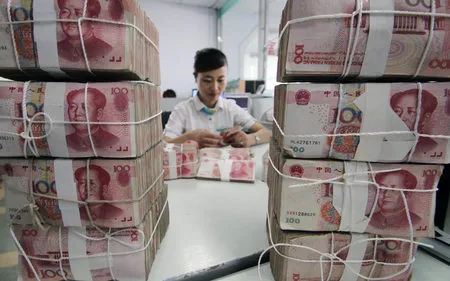
Don’t panic: China’s local debt still ‘manageable’ at RMB 10.7 trn
HSBC says nearly 80% of the total amount were bank loans.
This raised China's total public debt / GDP ratio to over 50%.
Here's more from HSBC:
| China's state auditing office today placed local governments' total debt tops RMB10.7trn, which is equal to 27% of GDP and of which nearly 80% were bank loans. Although the size is still manageable, Beijing needs to take immediate action to restructure these debts to mitigate defaulting risks. We think allowing local governments to issue bonds to be the most feasible option in the near-term. The state Auditing Office today released the result of its first ever audit of local government debt. The total size of local debt was placed at RMB10.7trn or USD 1.65trn at the end of 2010, larger than current RMB6trn of central government bonds outstanding, lifting China's total public debt/GDP ratio to over 50%. The local government debt to asset ratio stood at 70.5%. Out of the total local debt, nearly 50% were taken out as a part of an anti-global recession stimulus package during 2008-2010. Broken down by how proceeds were used, infrastructure investment accounted for 62% of the total, land purchases for another 11%, with the rest going towards education and other uses. By sources of funding, bank loans accounted for nearly 80%, topping RMB8.5trn. The local debt mainly of short-medium-term maturity, with nearly 70% due to mature within the next five years. The size of local government level debt was not as big as many commentators had speculated. Standing at 27% of national GDP, it is still manageable. It is worth noting here that over 70% of the proceeds has been used to invest in railway, bridge, land purchase, implying local governments' assets in hands has also increased along with their rising liabilities. So rising debt doesn't necessarily mean that local governments' balance sheets deteriorate. That said, there remain some serious problems. Chief among them are the lack of transparency and a mismatch between the maturity of these debt and the payback period of the long-term projects invested. Without real action going towards a restructuring of these debts, banks would face a real risk of defaulting in the coming years. As we argued earlier, there are a number of feasible and viable options for Beijing to choose from to restructure local debts before it is too late. Of these, we believe that the most likely resolution in the near-term will be giving local governments the right to issuance bonds themselves to enable pay back of their loans. Bottom line: Don't panic. Beijing can and will act to restructure local government debts to mitigate against risk of nonperforming banking loans in the coming years. |



![SBR 5 Lorem Ipsum News 2 [8 May]](https://cmg-qa.s3.ap-southeast-1.amazonaws.com/s3fs-public/styles/exclusive_featured_article/public/2025-05/a_hand_pointing_to_a_futuristic_technology_5b87c9d0e3_3.png.webp?itok=M3Hf-9XR)
![SBR 4 Lorem Ipsum [8 May Top Stories]](https://cmg-qa.s3.ap-southeast-1.amazonaws.com/s3fs-public/styles/exclusive_featured_article/public/2025-05/a_hand_pointing_to_a_futuristic_technology_5b87c9d0e3_2.png.webp?itok=2m5Wl0MX)


![Exclusive three SBR 12 Lorem Ipsum [8 May]](https://cmg-qa.s3.ap-southeast-1.amazonaws.com/s3fs-public/styles/exclusive_featured_article/public/2025-05/a_hand_pointing_to_a_futuristic_technology_5b87c9d0e3_11.png.webp?itok=8kn_UIfA)
![SBR 3 Lorem Ipsum [ Exclusive 2]](https://cmg-qa.s3.ap-southeast-1.amazonaws.com/s3fs-public/styles/exclusive_featured_article/public/2025-05/a_hand_pointing_to_a_futuristic_technology_5b87c9d0e3_1.png.webp?itok=YCyjLegJ)
![SBR 2 Lorem Ipsum [8 May]](https://cmg-qa.s3.ap-southeast-1.amazonaws.com/s3fs-public/styles/exclusive_featured_article/public/2025-05/a_hand_pointing_to_a_futuristic_technology_5b87c9d0e3_0.png.webp?itok=_cKD-29o)

![Video [Event News]](https://cmg-qa.s3.ap-southeast-1.amazonaws.com/s3fs-public/styles/event_news_featured_article/public/2025-05/screenshot-2025-05-08-at-4.58.53-pm_0.png.webp?itok=Kud35sMs)
![Event News SBR 9 Lorem Ipsum [8 may]](https://cmg-qa.s3.ap-southeast-1.amazonaws.com/s3fs-public/styles/event_news_thumbnail/public/2025-05/a_hand_pointing_to_a_futuristic_technology_5b87c9d0e3_8.png.webp?itok=DTh_dbYp)
![Event News SBR 9 Lorem Ipsum [8 May]](https://cmg-qa.s3.ap-southeast-1.amazonaws.com/s3fs-public/styles/event_news_thumbnail/public/2025-05/a_hand_pointing_to_a_futuristic_technology_5b87c9d0e3_7.png.webp?itok=vzDAzb6V)
![Event News SBR 8 Lorem Ipsum [8 May]](https://cmg-qa.s3.ap-southeast-1.amazonaws.com/s3fs-public/styles/event_news_thumbnail/public/2025-05/a_hand_pointing_to_a_futuristic_technology_5b87c9d0e3_6.png.webp?itok=jvHFc4P6)
![Video [Event News]](https://cmg-qa.s3.ap-southeast-1.amazonaws.com/s3fs-public/styles/video_thumbnail/public/2025-05/screenshot-2025-05-08-at-4.58.53-pm_0.png.webp?itok=yZnI0YBb)
![Video 1 SBR [8 May]](https://cmg-qa.s3.ap-southeast-1.amazonaws.com/s3fs-public/styles/video_thumbnail/public/2025-05/screenshot-2025-05-08-at-4.58.53-pm.png.webp?itok=9AAeRz_k)

 Advertise
Advertise

